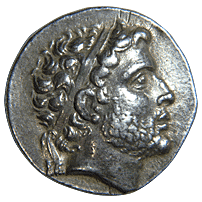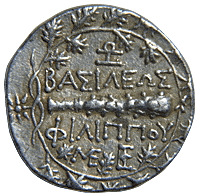 |

Silver didrachm, king of Macedon
Grade: good VF / Price: $650
 |
 |
Obverse: diademed head of king right. Reverse: BASILEWS / FILIPPOU above and below club right, three monograms in field, all within oak wreath outside of which to left is star. Reference: Boston 718 variant.
Philip V was the son of King Demetrius II (239-229 BC) and at was only nine at the time of his father's death in battle against the Dardanians. The regency was assumed by the late monarch's cousin, Antigonus Doson, who took the title of king and ruled wisely down to the time of his death in 221 BC. Philip V was now old enough to assume the responsibilities of regal power and achieved considerable renown in the early years of his reign through participation in the so-called 'Social War' of 220-217 BC. Soon afterwards, however, the young monarch made the potentially fatal mistake of taking up arms against the Romans in Illyria, subsequently compounding his blunder by negotiating a treaty with Hannibal, the sworn enemy of Rome (215 BC). Final resolution of the antagonism which now existed between Rome and the Macedonian kingdom was delayed until 197 BC, when Philip V was decisively defeated by the Roman general Flamininus at the battle of Cynoscephalae in Thessaly - one of the pivotal events in the history of the Mediterranean world during the Hellenistic period. The power of the great Macedonian kingdom was now broken forever. Under the terms of the peace treaty Philip was obliged to confine his activities to Macedonia itself, to pay one thousand talents war indemnity, to surrender his fleet, and to give up hostages, including his own younger son Demetrius. Although he reigned for a further eighteen years Philip was no longer a significant factor in the politics of the eastern Mediterranean area. He died at Amphipolis in his sixtieth year (179 BC) and was succeeded on the throne by his elder son, Perseus, who was to be the last king of Macedon. The issue of silver didrachms by Philip V belongs to the final decade of his reign. This excellent example bears on its obverse a sensitive bearded portrait of the aging monarch, whilst the club on the reverse is symbolic of Heracles, the national hero of Macedonia.

|
 |

